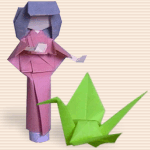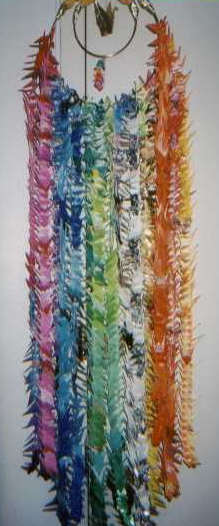 |
|
|||
|
WHAT IS ORIGAMI
|
||||
|
Origami is the Japanese word for paper folding. ORI means to fold and KAMI means paper. Together, they form the word, "origami." It is an art form that has been handed down from parent to child through many generations. Origami involves the creation of paper forms usually entirely by folding. Animals, birds, fish, geometric shapes, puppets, toys and masks are among the models that even very young children can learn to make in just one sitting. |
 |
||||
|
The art of making paper from pulp originated in China in the year 102A.D. Paper then became more available to the masses. The secret of making paper was kept in China for several hundred years and finally made its way through Korea and into Japan. A Buddhist monk is said to have carried this secret .The introduction of paper making to Japan several hundred years later coincided with the development of their religion and soon became part of the lives of its people. Colors and silk threads were added and origami was held in high esteem. Gifts were decorated with "noshi." Noshi had particular fold patterns depending on the gift. In Japan, at one
time origami was taught in schools but today, children are generally
taught origami at home. Holidays are celebrated with colorful origami
decorations made by the family. On children's day (formerly boy's day),
children make colorful carp: a fish that swims upstream, against the
current. This symbolizes strength. During the summer, Tanabata, The
Star Festival is celebrated. Live bamboo branches are decorated with
origami stars and other paper decorations in a manner which brings to
mind a decorated Christmas tree. Perhaps the most well known origami model is the crane. It has become the international symbol of peace. In Japan every child eventually learns to make the crane. Eleanor Coerr is credited with popularizing the crane with her book, "Sadako and 1,000 Paper Cranes." This book, which is widely available, tells the story of a young girl who was exposed to the radiation from the atomic bomb that the U.S., dropped which helped to end World War Two. Several years later she develops leukemia. Her friend visits her in the hospital with an origami crane. She tells Sakako that the crane is a symbol of health and that if Sadako can make 1,000 cranes she will be well. Her friend proceeds to teach her to make the crane: it isn't easy but when Sadako masters it, she begins her quest to make 999 more. She is resolved to be brave and making the cranes takes her mind off her illness. As she attracts the attention of the hospital staff and other visitors, they provide her with x-ray foil wrappers, magazines and other papers for her project. As other patients show interest, she stops folding and teaches them to make the cranes too. Learning that her illness came as a result of war, Sadako spreads her message of peace as she folds her cranes. Soon she has folded hundreds of cranes. Her health improves and she is allowed to come home. But, when her illness returns and her strength weakens, sadly, she isn't able to complete her project. With less than 700 cranes completed, Sadako lapses into a coma and dies. When her classmates realize that she had not been able to complete her dream they all decide to learn how to fold the crane. Soon the 1,000 cranes are complete.
|
|||||
|
The children decide to write to other children all over Japan to tell them of the story of Sadako and ask them to contribute money for a monument in her name to spread her message of peace. When the Japanese government learns of this plan they decide to rename a park in Hiroshima "Peace Park." There they erect a huge statue with a replica of Sakako holding up a giant crane. Her classmates were given the honor of deciding what to write on the base of the statue. This is what they chose: This is our
cry So you see, the work of just one child has made people all over the world aware of the need for a peace. When you have completed some "First Steps" in origami, you can try your hand at the crane. The instructions can be found here. |
 The picture by Kathleen O'Regan |
||||
|
There is an ongoing debate as to who were the first paper folders. Certainly, paper folding is a part of Chinese culture: perhaps they were the first. When people are buried, replicas of items are folded and included in their tombs. Also, the Chinese have always been frugal people who wouldn't waste something that could be reused. So, a paper that has served its original purpose now can be recycled for origami. Many origami toys were developed by the Chinese. The most famous of these is the "waterbomb." Children make balloons out of paper, fill them with water and throw them down with a loud splat. Today, paper folders refer to the base of the waterbomb as the "waterbomb base." Europeans have evidence of Baptismal certificates dating back hundreds of years with a recognizable crease pattern. As trade among nations developed, magicians often traveled to distant lands bringing with them the magic of origami. Today the strongest evidence points to the Ancient Egyptians as the first paper folders. A map to the tombs in the Valley of the Kings was found. It resides in a museum in Milan, Italy. It is more than 2.000 years old. Here the papyrus (The first known paper dating back 4.500 years is made in a laborious process from papyrus reeds.) shows creases on the map. This crease pattern is similar to the way maps are folded today. However, a sheet of papyrus took a week to make and it is brittle. Probably there was very little other paper folding done by the Egyptians. Though the debate continues as to who was first, each nation brought something to the fold and you have a chance to do that too. After you learn some of the basics, start experimenting with folding paper. You can make your own folds and become part of the history of origami. |
|||||

